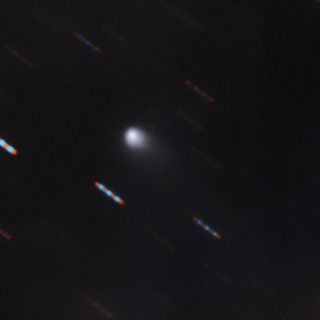
The first color image of the comet C/2019 Q4 (Borisov), which astronomers believe to be the first known interstellar comet ever identified, was captured by the Gemini North telescope at Hawaii’s Mauna Kea. Gemini North acquired four 60-second exposures in two color bands (red and green). The blue and red lines are background stars moving in the background.
(Image credit: Gemini Observatory/NSF/AURA/Travis Rector)
Astronomers have taken the first color photo of a potentially interstellar comet, and it looks spectacular.
The colored image allowed astronomers to spot a comet tail, which is the product of gases flowing off its surface. This tail is unique among the suspected interstellar visitors to our solar system. Of course, there have only been two such guests so far — this comet, named Comet C/2019 Q4 (Borisov), and ‘Oumuamua, which is a long asteroid or space rock with no obvious gases flowing from its surface.
Astronomers nabbed the view the night of Sept. 9-10 using the Gemini Multi-Object Spectrograph on the Gemini North Telescope on Hawaii’s Mauna Kea.
Related: This Comet Might Be from Interstellar Space!
“This image was possible because of Gemini’s ability to rapidly adjust observations and observe objects like this, which have very short windows of visibility,” Andrew Stephens, who coordinated the observations at the Gemini Observatory, said in a statement. “However, we really had to scramble for this one since we got the final details at 3:00 a.m. [local time] and were observing it by 4:45!”
The comet was discovered by Russian amateur astronomer Gennady Borisov on Aug. 30. Right now its path in the Earth’s sky brings it close to the sun, making it difficult to observe because it is best visible in twilight. In the next few months, the comet is expected to move further away from the sun — making it easier to see.
For these new Gemini observations, the astronomical team obtained them thanks to a target-of-opportunity program led by Piotr Guzik and Michal Drahus at the Jagiellonian University in Krakow, Poland. A research paper, led by Guzik, was uploaded to the preprint server Arxiv on Thursday (Sept. 12) and has been submitted to a journal for publication. (Papers on arXiv are not yet peer-reviewed.)
Astronomers aren’t certain if this comet originated from outside our solar system, because its path through space isn’t well defined. So far, however, the data suggests that its path is a hyperbola — meaning that it is dipping into the solar system before flying out again. Most comets and asteroids tracked in the solar system have elliptical orbits, which range from nearly circular to egg-shaped to long-looped orbits.
Follow Elizabeth Howell on Twitter @howellspace. Follow us on Twitter @Spacedotcom and on Facebook.






